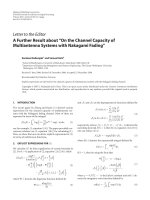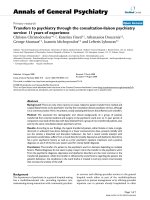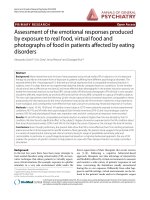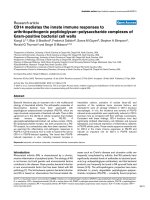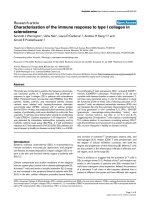Báo cáo y học: "Letter to the edito" pptx
Bạn đang xem bản rút gọn của tài liệu. Xem và tải ngay bản đầy đủ của tài liệu tại đây (31.34 KB, 2 trang )
120
Critical Care February 2005 Vol 9 No 1 Rosival
In the recent Bench-to-bedside review from Gehlback and
Schmidt [1] there are several discrepancies with the
literature. For the readers of Critical Care, it would be useful
if the authors could provide explanations for the following.
On page 260 the authors wrote that, ‘… lowering the arterial
pH has rather convincingly been shown to cause a decrease
in cardiac contractility.’ According to Maury and coworkers
[2], in contrast to experimental animals and isolated organs
or cells, in humans very low blood pH has no adverse effects
on the cardiovascular system. Are there any published
reports that refute the findings of Maury and coworkers? On
the other hand, the authors did not mention that low blood
pH has detrimental effects on the central nervous system
(e.g. see the report by Alberti and coworkers [3]). The
glycolytic enzyme phosphofructokinase is pH dependent and
its activity decreases with decreasing pH; thus, utilization of
glucose is impaired with reduced pH levels. Because
glucose is the main energy yielding substrate for brain cells,
the clinical consequences of decreasing blood pH are
drowsiness, stupor, coma and, ultimately, death.
On page 261 the authors wrote, ‘No benefit from sodium
bicarbonate has been found in the management of diabetic
ketoacidosis.’, citing reports from Lever and Jaspan [4] and
from Morris and coworkers [5]. This is a misinterpretation. In the
study conducted by Lever and Jaspan [4], those investigators
described 27 patients with diabetic ketoacidosis in a ‘deep
coma’ and blood pH below 7.10. After administration of sodium
bicarbonate, the blood pH normalized and all 27 patients
recovered to full alertness. Are there any published reports
indicating zero death rates in a similar number of comatose
patients with diabetic ketoacidosis and very low blood pH,
without increasing blood pH and without administering sodium
bicarbonate? Morris and coworkers [5] did not report on
comatose patients, and therefore it is impossible to conclude
whether the applied therapies were life saving or not.
On page 259 the authors wrote, ‘… we understand poorly
both the effects of an elevated arterial H
+
concentration
([H
+
]) as well as the effects of attempting to correct it …’,
and on page 263 they state that, ‘… it is unclear whether it is
ever advantageous to administer a buffering agent to a
patient with lactic acidosis …’. Ahmad and Beckett [6]
described a comatose patient with extreme lactic acidosis
(blood pH 6.389, lactate 24.0 mmol/l) caused by metformin
treatment for diabetes mellitus. After infusions of sodium
bicarbonate, blood pH increased to normal values, the
patient recovered to full alertness and was later discharged
from hospital. According to the authors, what would be the
correct therapy in a similar patient?
Competing interests
The author(s) declare that they have no competing interests.
Letter
Letter to the editor
Viktor Rosival
Clinical Biochemist, Department of Clinical Biochemistry, Derer’s Hospital, Bratislava, Slovakia
Correspondence: Viktor Rosival,
Published online: 15 December 2004 Critical Care 2005, 9:120-121 (DOI 10.1186/cc3017)
This article is online at />© 2004 BioMed Central Ltd
Authors’ response
Brian K Gehlbach and Gregory A Schmidt
We appreciate the opportunity to amplify the points we
made in our recent review [1]. It has been known for more
than a century that acidosis impairs cardiac contractility [7],
and this has also been shown for human atrial and
ventricular muscle [8]. Dr Rosival cites a study of
echocardiographic fractional shortening to support his
assertion that low blood pH has no adverse effects on the
cardiovascular system [2]. The 10 patients reported in that
brief letter were found to have ‘normal‘ fractional shortening,
but there was no formal comparison of fractional shortening
before and after treatment. Furthermore, fractional
shortening is a crude measurement that groups not only
ventricular contractility but also loading conditions and
compensatory responses. We find the results of that study
to be in general agreement with our review, which stated
that, ‘The net influence of acidosis on the cardiovascular
121
Available online />system is complicated, however, by concomitant stimulation
of the sympathetic-adrenal axis.’
Low blood pH may have detrimental effects on the nervous
system, as suggested by Dr Rosival, but there are few data to
support this assertion. The glycolytic enzyme
phosphofructokinase is affected by pH, but also by insulin
levels and host of other mediators. Whether any alteration in
glycolytic activity relates to the encephalopathy of
ketoacidosis is unknown. Very little research into the
mechanisms of brain dysfunction in this condition has been
conducted, but it has been speculated that disturbances in
pH, electrolytes, and osmolality, as well as ketone body
effects, endothelial injury, lipid peroxidation, vascular
dysregulation and nitric oxide-induced disruption of the
blood–brain barrier, may be to blame. Cerebral edema, which
plays a role in some patients [9], has been linked to
treatment with bicarbonate [10].
In rebutting the conclusion of Lever and Jaspan’s
retrospective analysis of 95 patients with diabetic
ketoacidosis [4], Dr Rosival cites the 100% survival of 27
patients in ‘deep coma’ and with a blood pH below 7.10 who
received sodium bicarbonate as proof of the efficacy of this
therapy. To suggest that the benefit of a therapy is
established through such a post hoc subgroup analysis of a
negative retrospective study perpetuates the idea that
sodium bicarbonate should not be subjected to the same
burden of proof as any other therapy. Moreover, all of the
patients who were not subjected to bicarbonate infusion also
survived, and the mean time to achieve complete return of
consciousness was identical (4 hours) in those treated with
and those treated without bicarbonate.
Dr Rosival asks us what therapy we would prescribe for a
patient with severe lactic acidosis due to metformin. This is
easy; because metformin is readily dialyzable, we would
perform dialysis.
Competing interests
The author(s) declare that they have no competing interests.
References
1. Gehlbach BK, Schmidt GA: Bench-to-bedside review: Treating
acid–base abnormalities in the intensive care unit – the role
of buffers. Crit Care 2004, 8:259-265.
2. Maury E, Vassal T, Offenstadt G: Cardiac contractility during
severe ketoacidosis. N Engl J Med 1999, 341:1938.
3. Alberti KGMM, Zimmet P, DeFronzo RA, Keen H: Diabetic
ketoacidosis and hyperglycaemic non-ketotic coma. In: Inter-
national Textbook of Diabetes Mellitus, 2nd ed. Chichester: John
Wiley and Sons; 1997:1215-1229.
4. Lever E, Jaspan JB: Sodium bicarbonate therapy in severe dia-
betic ketoacidosis. Am J Med 1983, 75:263-268.
5. Morris LR, Murphy MB, Kitabchi AE: Bicarbonate therapy in
severe diabetic ketoacidosis. Ann Intern Med 1986, 105:836-
840.
6. Ahmad S, Beckett M: Recovery from pH 6.38: lactic acidosis
complicated by hypothermia. Emerg Med J 2002, 19:169-171.
7. Gaskell WH: On the tonicity of the heart and blood vessels. J
Physiol Lond 1880, 3:48-75.
8. Cingolani HE, Faulkner SL, Mattiazzi AR, Bender HW, Graham TP
Jr: Depression of human myocardial contractility with ‘respira-
tory’ and ‘metabolic’ acidosis. Surgery 1975, 77:427-432.
9. Morgan TJ: The meaning of acid-base abnormalities in the
intensive care unit: Part III – effects of fluid administration.
Critical Care 2005, 9:in press.
10. Glaser N, Barnett P, McCaslin I, Nelson D, Trainor J, Louie J,
Kaufman F, Quayle K, Roback M, Malley R, et al.: Risk factors for
cerebral edema in children with diabetic ketoacidosis. N Engl
J Med 2001, 344:264-269.



